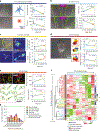Biophysical and biomolecular determination of cellular age in humans
- PMID: 31372309
- PMCID: PMC6675017
- DOI: 10.1038/s41551-017-0093
Biophysical and biomolecular determination of cellular age in humans
Abstract
Ageing research has focused either on assessing organ- and tissue-based changes, such as lung capacity and cardiac function, or on changes at the molecular scale such as gene expression, epigenetic modifications and metabolism. Here, by using a cohort of 32 samples of primary dermal fibroblasts collected from individuals between 2 and 96 years of age, we show that the degradation of functional cellular biophysical features-including cell mechanics, traction strength, morphology and migratory potential-and associated descriptors of cellular heterogeneity predict cellular age with higher accuracy than conventional biomolecular markers. We also demonstrate the use of high-throughput single-cell technologies, together with a deterministic model based on cellular features, to compute the cellular age of apparently healthy males and females, and to explore these relationships in cells from individuals with Werner syndrome and Hutchinson-Gilford progeria syndrome, two rare genetic conditions that result in phenotypes that show aspects of premature ageing. Our findings suggest that the quantification of cellular age may be used to stratify individuals on the basis of cellular phenotypes and serve as a biological proxy of healthspan.
Figures





Similar articles
-
Prematurely aged children: molecular alterations leading to Hutchinson-Gilford progeria and Werner syndromes.Curr Aging Sci. 2008 Dec;1(3):202-12. doi: 10.2174/1874609810801030202. Curr Aging Sci. 2008. PMID: 20021393 Review.
-
Metformin alleviates ageing cellular phenotypes in Hutchinson-Gilford progeria syndrome dermal fibroblasts.Exp Dermatol. 2017 Oct;26(10):889-895. doi: 10.1111/exd.13323. Epub 2017 May 3. Exp Dermatol. 2017. PMID: 28192606
-
Aging of Hutchinson-Gilford progeria syndrome fibroblasts is characterised by hyperproliferation and increased apoptosis.Exp Gerontol. 2004 May;39(5):717-24. doi: 10.1016/j.exger.2004.02.002. Exp Gerontol. 2004. PMID: 15130666
-
Recapitulation of premature ageing with iPSCs from Hutchinson-Gilford progeria syndrome.Nature. 2011 Apr 14;472(7342):221-5. doi: 10.1038/nature09879. Epub 2011 Feb 23. Nature. 2011. PMID: 21346760 Free PMC article.
-
Mutations Involved in Premature-Ageing Syndromes.Appl Clin Genet. 2021 Jun 2;14:279-295. doi: 10.2147/TACG.S273525. eCollection 2021. Appl Clin Genet. 2021. PMID: 34103969 Free PMC article. Review.
Cited by
-
Profiling Dynamic Patterns of Single-Cell Motility.Adv Sci (Weinh). 2024 Oct;11(38):e2400918. doi: 10.1002/advs.202400918. Epub 2024 Aug 13. Adv Sci (Weinh). 2024. PMID: 39136147 Free PMC article.
-
qMAP enabled microanatomical mapping of human skin aging.bioRxiv [Preprint]. 2024 Jul 6:2024.04.03.588011. doi: 10.1101/2024.04.03.588011. bioRxiv. 2024. PMID: 39005293 Free PMC article. Preprint.
-
Single-cell morphology encodes functional subtypes of senescence in aging human dermal fibroblasts.bioRxiv [Preprint]. 2024 May 16:2024.05.10.593637. doi: 10.1101/2024.05.10.593637. bioRxiv. 2024. PMID: 38798365 Free PMC article. Preprint.
-
High-throughput mechanical phenotyping and transcriptomics of single cells.Nat Commun. 2024 May 17;15(1):3812. doi: 10.1038/s41467-024-48088-5. Nat Commun. 2024. PMID: 38760380 Free PMC article.
-
Model design choices impact biological insight: Unpacking the broad landscape of spatial-temporal model development decisions.PLoS Comput Biol. 2024 Mar 8;20(3):e1011917. doi: 10.1371/journal.pcbi.1011917. eCollection 2024 Mar. PLoS Comput Biol. 2024. PMID: 38457450 Free PMC article.
References
-
- Smith BD, Smith GL, Hurria A, Hortobagyi GN & Buchholz TA Future of cancer incidence in the United States: burdens upon an aging, changing nation. J. Clin. Oncol. 27, 2758–2765 (2009). - PubMed
Grants and funding
LinkOut - more resources
Full Text Sources
Other Literature Sources

